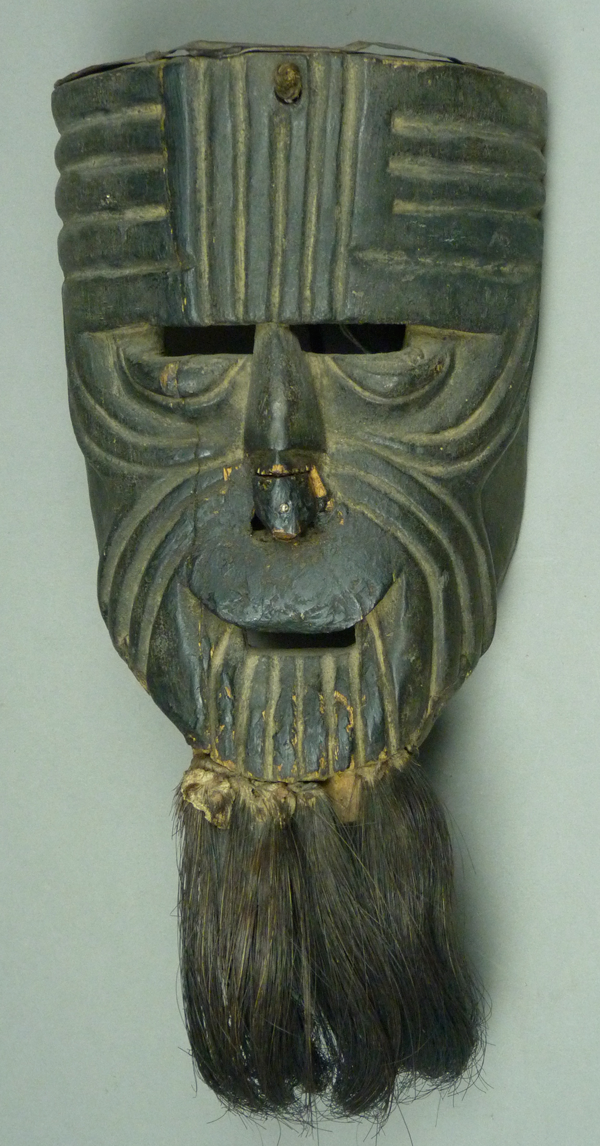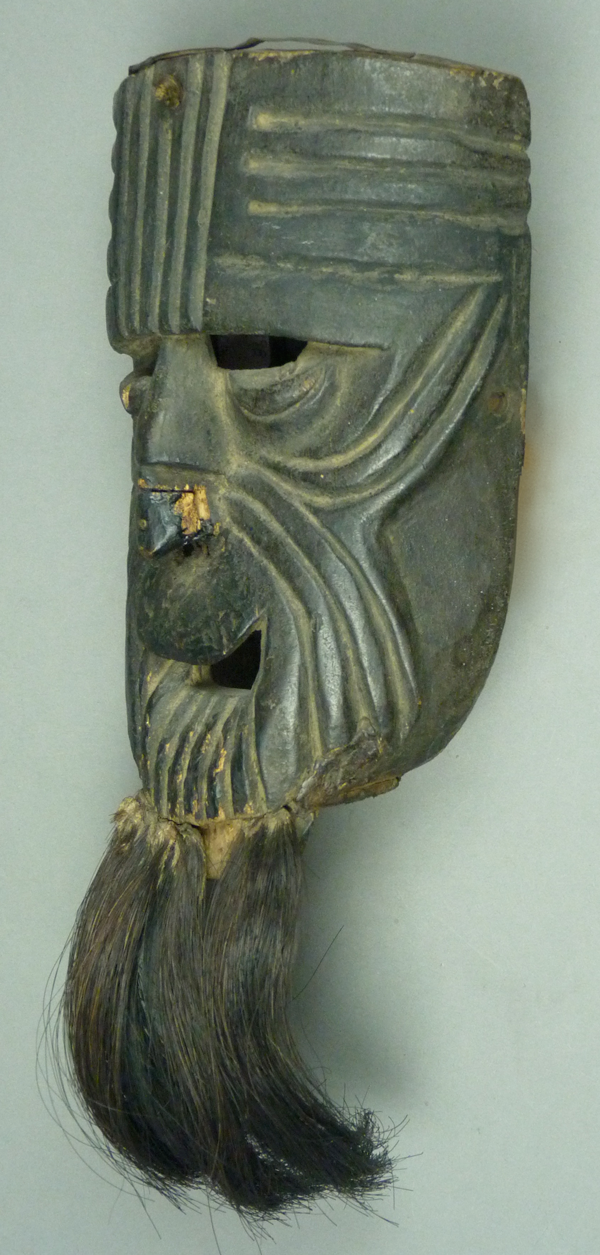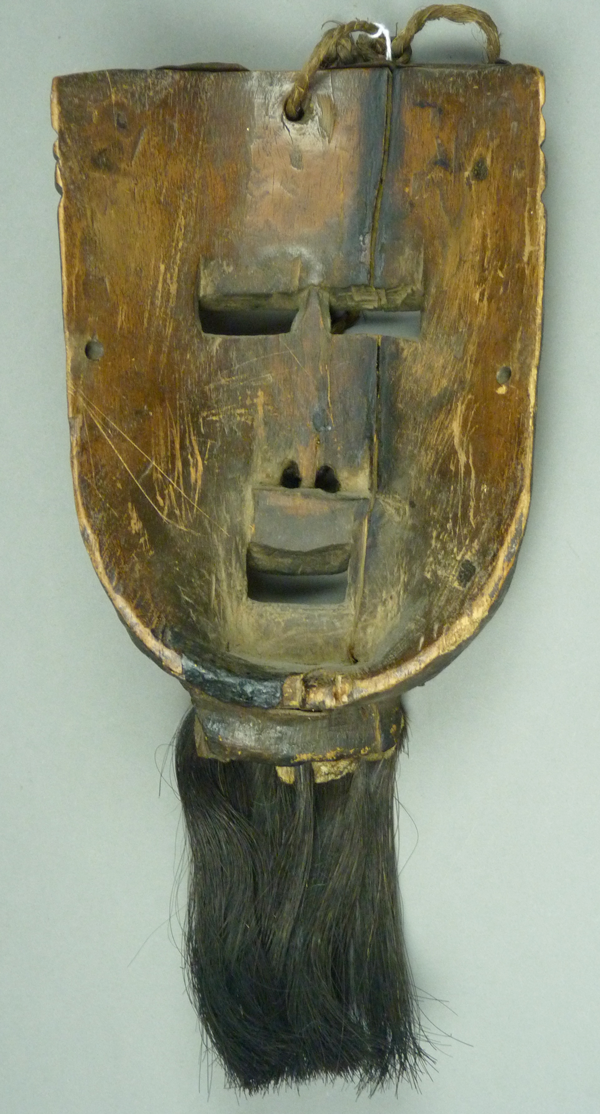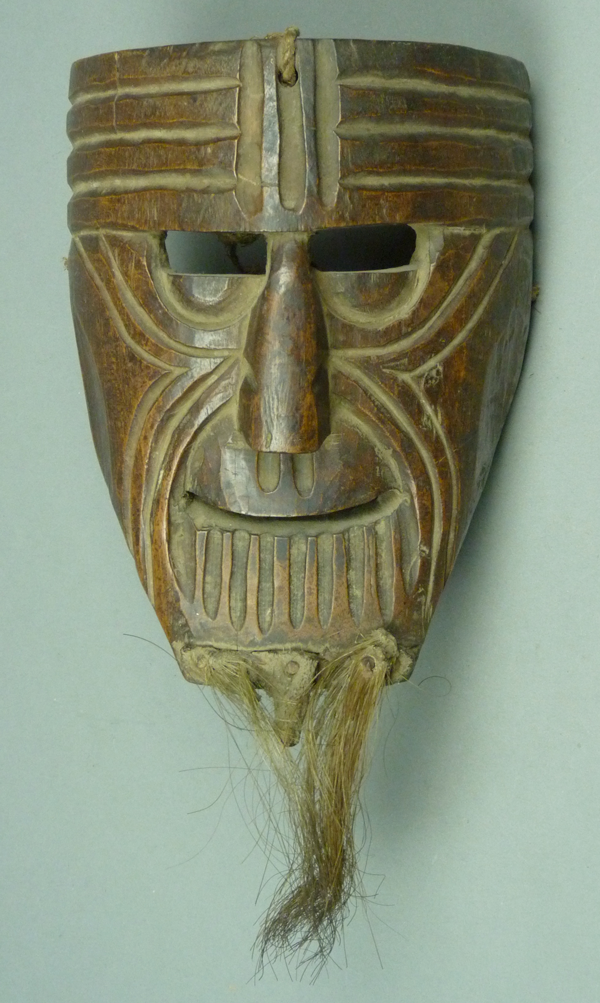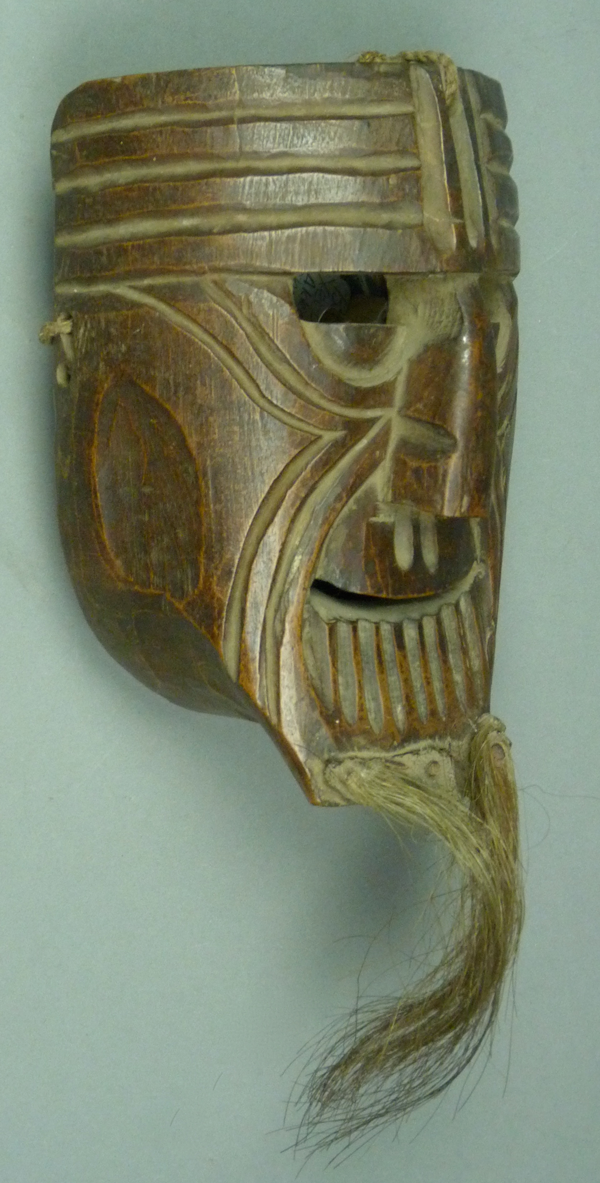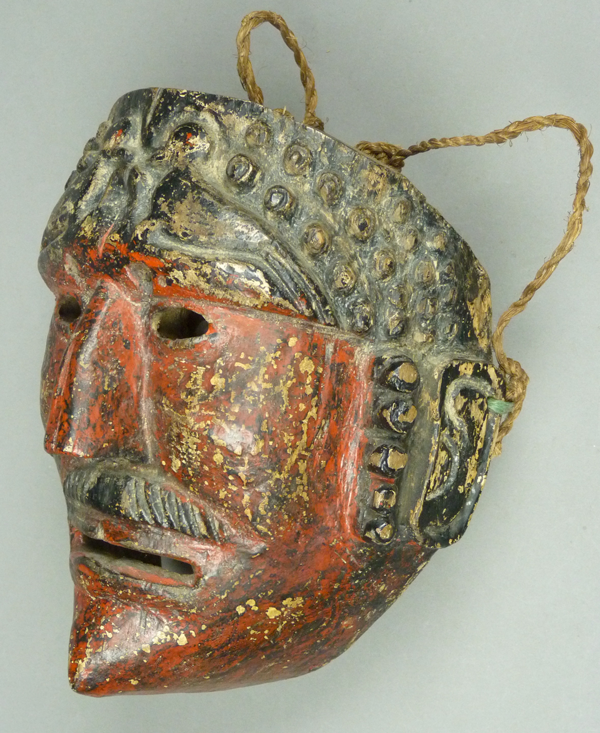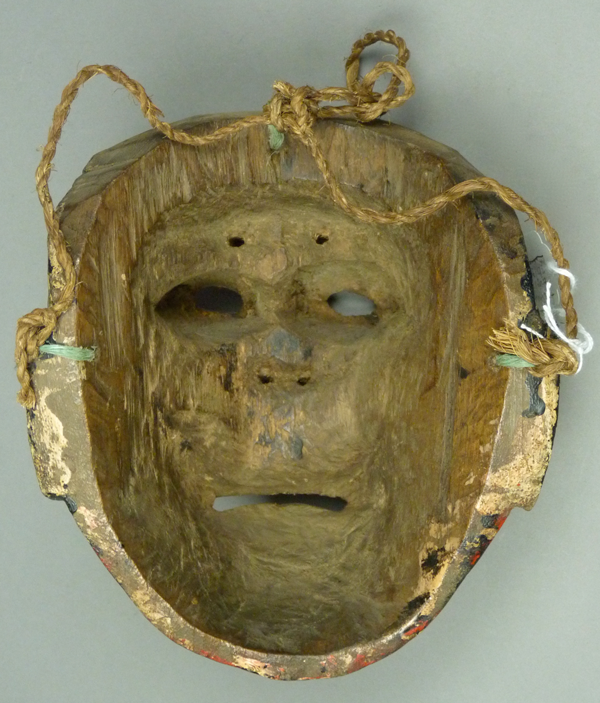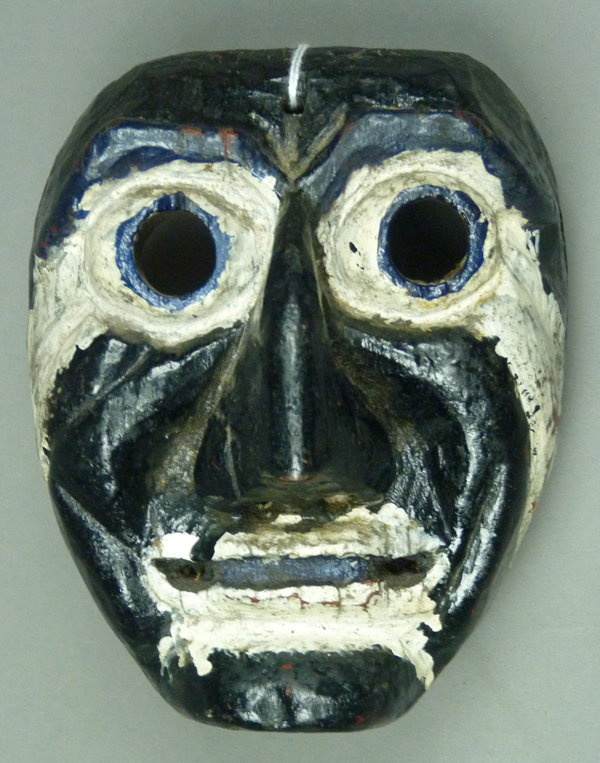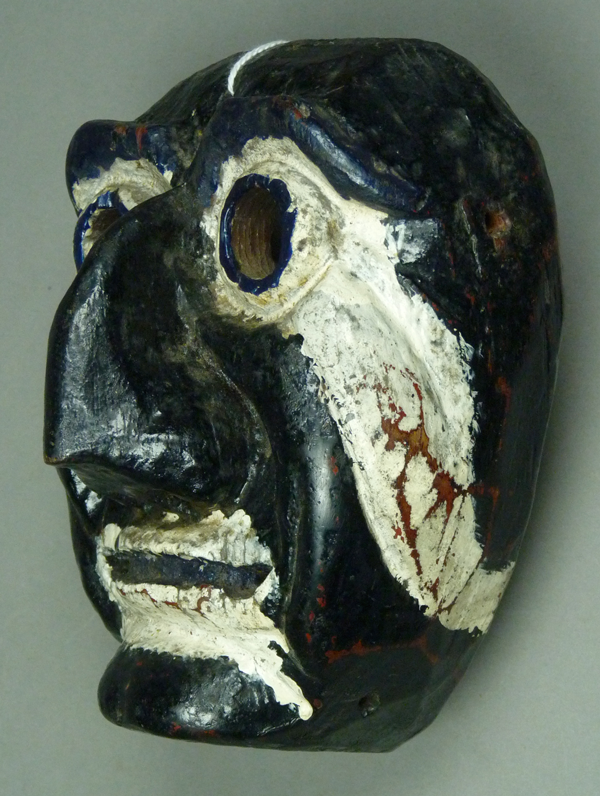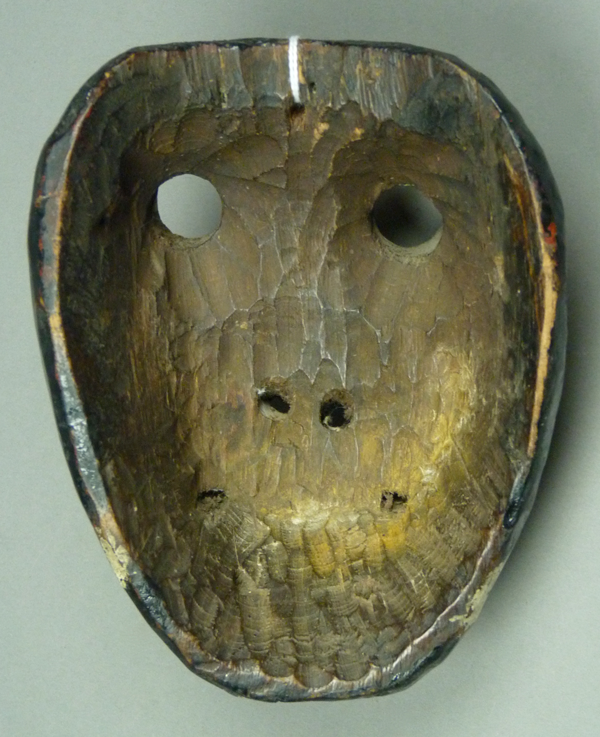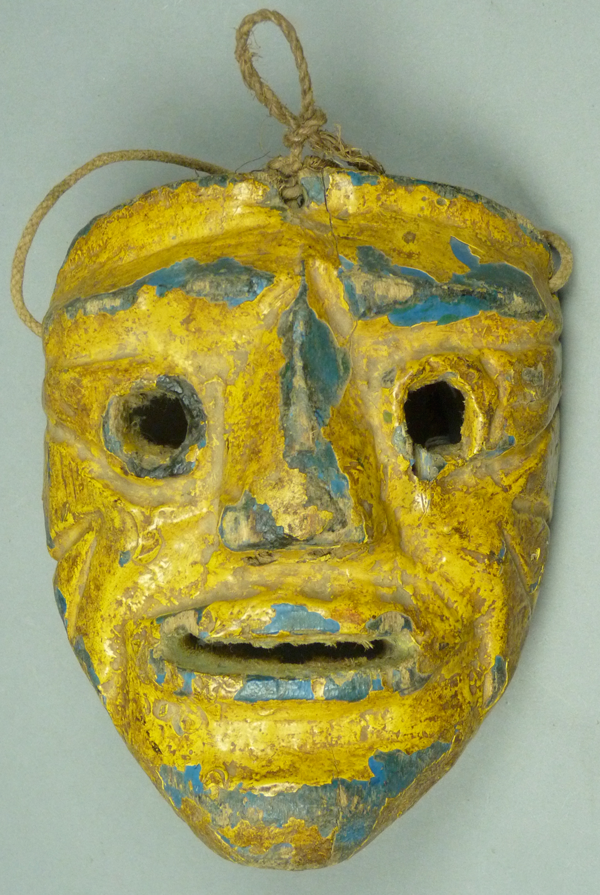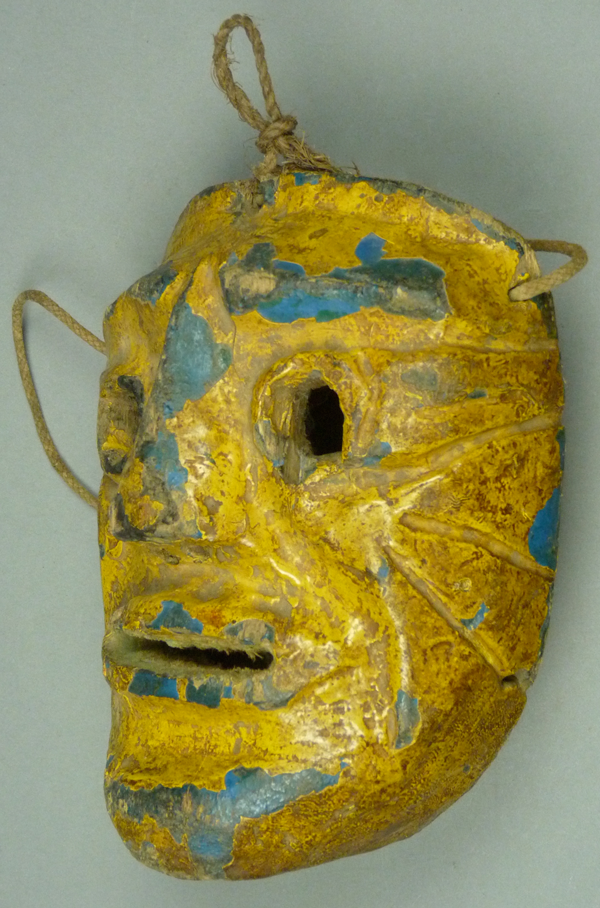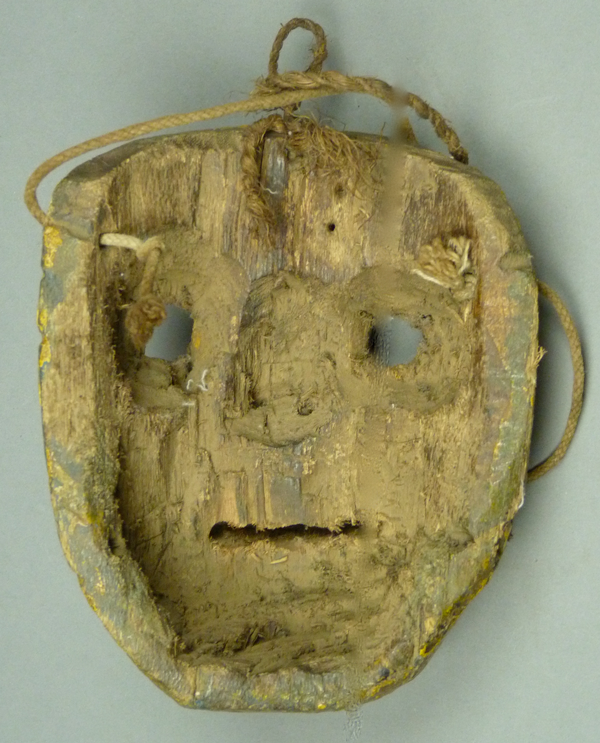This week I will discuss Xacalcojes and some other masks, next week will focus on Diablo masks from Guatemala, and that will complete this series of posts about Guatemalan masks. On September 21 I will initiate a series of posts about Juanegros masks and then Xantolos masks, both used during the celebration of Day of the Dead in the Huasteca area of Mexico.
The Xacalcojes dance features masks that are very different from those you have seen in the preceding posts. They seem mysterious and exotic. Here is a very old one from my collection. I bought this mask from Spencer Throckmorton in August 1995.
The upper lip of this mask is curved and beveled, in sharp contrast to the rectangular shape of the sides and floor of the mouth. This results in an ambiguous expression, which is desirable because the mask is meant to express sadness and then happiness. The tip of the nose was broken and patched.
Note the repair to the tip of the nose. From this angle one can better appreciate the overhanging design of the upper lip. My friend Jay Vannini has described these masks as having “waterfall” mouths. This mask is 8½ inches long without the beard and 12½ inches with the beard. It is 5½ inches wide and 2½ inches deep.
This mask had split completely in two and was bound together by strips of tin across the top of the rim and under the chin. You can readily see that the staining on the back of this mask is quite dark, as if it has been danced for many years.
I found a reference on the web to the Xacalcojes Dance. This states that—
“Xalcalcojes dancing happens at Easter. They wear masks to represent the pain of the death of Jesus.”
http://proyectosculturales.wikispaces.com/Guatemalan+Dance+and+Music
Pieper (2006, pages 266 and 267) adds some information about the Xalcalcojes Dance that he found at the National Museum of Archeology in Guatemala City. “The dance is of colonial origin,” and occurs on Holy Saturday, the day before Easter Sunday. We know, from similar dances and “Passion Plays” in Mexico, that such dramatic presentations were invented or introduced by Christian missionaries in the context of the conversion of the Indians to Christianity. “Xalcalcog means change of face/expression or activity,” Pieper continues; evidently these wrinkled faces can reflect extremes of sadness and then joy in response to Christ’s changing status—”The dancers cry because of the death of Jesus. On Easter, with the Resurrection of Jesus, they shout with joy and their dance becomes happy…” They demonstrate their happiness by staging a bullfight. Pieper included a mask that he dated c. 1800s, from Totonicapán, which closely resembles the mask we have just examined. These two masks share the interesting detail that I have already discussed, in that they have mouths carved with somber or neutral expressions, while contemporary Xacalcojes masks are often carved with broad grins.
Brown and Rossilli (2008 Volume 1, pages 301 to 311) describe and illustrate other juegos (games or dramas), in addition to bullfighting, that occur in the course of this performance. The authors refer to these as “satirical plays.” On reflection, these appear to be indirect references to the life and suffering of Christ; see if you agree.
1. In “La Panaderia” (the Bread Bakery) the dancers pantomime the baking of small loaves of bread and then actual loaves are distributed to the crowd. This reminds one, of course, of the Biblical story of the loaves and fishes.
2. A “Doctor” is called to treat one of the other dancers. He arrives “by helicopter” (actually he arrives in a wheelbarrow). The Doctor has a tail and he carries a “witchdoctor’s doll.” His surgery and medicines apparently fail, he is arrested, and bound with chains. I wonder who he symbolizes; is this a veiled description of Christ’s reversal of status during holy week, when the crowd turned on him, leading to his crucifixion? Or is this a portrayal of the devil?
3. The dancers receive the “gift” of an old straw hat, they fight among themselves over who shall own it, and the hat is invariably destroyed. This reminds me of the story that bystanders fought over Christ’s clothing at the time of his crucifixion.
Here is a second Xacalcojes mask. I got this mask from the Cavin Morris Gallery in January 1995.
This mask too has a muted smile, compared to those contemporary masks in the photos of Pieper, Brown, and Rossilli.
This mask is 7½ inches tall without the beard, 5½ inches wide, and 3¼ inches deep.
This mask probably dates to the mid-20th century.
To my disappointment, I was unable to find a video of this dance. There are interpretations of the Xacalcojes by Ballet Folklorico groups that you can readily discover by searching, but I found them stilted and unconvincing.
Two more Xacalcojes masks follow, from a private collection. The first of these seems fairly old.
This is another older mask that lacks any hint of a smile.
This view emphasizes the slab-like shape of the goatee on these masks.
This mask too has an obviously old back.
The next of these Xacalcój mask is much more recent, but it too has a serious expression.
The lower lip or chin of this mask has a highly stylized shape.
The back demonstrates moderate wear.
Brown and Rossilli (2008 Volume 1, page 312) also described the Baile Salguaches, from Santo Tomás La Union, Suchitepéquez, a dance that mainly differs from the Xacalcojes dance because it has another name; the dancers wear masks that closely resemble the Xacalcojes masks. Here is one of those masks, from a private collection.
Note that all five of these Xacalcojes type masks have a series of parallel or radiating grooves under the open mouth.
This mask too has obvious evidence of use.
The rest of this post will focus on other masks and dances.
Brown and Rossilli devoted a chapter (2008 Volume 1, pages 293-300) to the Baile Currunes, from Joyabaj, Guatemala. These masks are large, with wrinkled black or brown faces. The authors note that Currunes is the name that these people call themselves. Here is one of those masks from a private collection. Isn’t it beautiful?
The carving of the eyes is particularly delicate.
The upper teeth were also carefully carved, but they were evidently fragile.
Look at the lower lip and chin in profile.
The back of this mask has dark patina from considerable use.
The next mask, from yet another dance, is of interest because it looks like one thing when it is really something else. With the pair of birds on the forehead, this mask looks like a Spaniard mask from the Conquista dance. Brown and Rossilli (2008 Volume 1) show such masks on pages 20 (Doce Pares de Francia), page 94 (Conquista), and pages 196 and 199 (Baile Compadres). However, all of those masks have light pink faces, golden hair and golden birds, while this mask has a dark red face and both the hair and the birds are black. In Guatemalan Masks: A Portfolio (2009), Brown shows a m/l exact duplicate of this mask dancing in the Baile Tunes or Tuncunes in San Bernardino Suchtepéquez. One learns from that photo that the small holes over the eyes are there to hold fasteners for a small mirror.
Brown and Rossilli told more about this dance in their 2008 work (Volume 2, pages 328 to 337). In the dance one of the masked dancers carries a wooden frame on his back; this frame is packed with dried cornstalks and fireworks, which are set on fire as the dancer walks. The burning husks symbolize the practice of burning the husks and additional vegetation on the milpa (cornfield) in preparation for planting the cornfield for a new season. There is also a framework bull in the dance to participate in a mock bullfight.
I bought this mask from Maya Jones in Madrid, New Mexico in 1996.
This mask is 8 inches tall, 7 inches wide, and 4 inches deep.
The back indicates a history of significant use.
In my early posts ( July 2014 ) I mentioned the Voladores or “flyers” in the Sierra de Puebla; I described them at length in my book about the Sierra de Puebla. That ceremonial performance is also found in Guatemala. Brown and Rossilli (2008 Volume 2, pages 526-531) report that the flyers wear monkey masks and costumes in the communities that they visited, and that other Guatemalan performances were probably similar. The next mask, another from a private collection, was said to have been worn by a Volador, although it has a human rather than a monkey face. The buyer sought other opinions and the feedback suggested the possibility that this is really another of those dark red Patrón masks for the Patxcar dance; you may recall that I showed several in this color. I am illustrating a common problem—a mask is collected without a record of provenance, a dealer buys it, and then in order to sell it the dealer attempts to guess what it might be. Then the mask is offered to you or to me, it is beautiful, so one of us buys it. With it we buy the dealer’s guess. After a while we develop our own guesses. With experience, over time, the true identity of the mystery becomes clearer, even if not absolutely certain. In this case, as I continue to examine this mask from a position of suspended judgement, I realize that, with its big brows and its elaborate mustache, it looks a lot like the Moro masks I showed you last week. I didn’t think of this right away, because I was in love with the idea that it might have been worn by a Volador. But because this is a mask from Guatemala, where very similar masks can appear in not so similar dances, we might be wise to continue to suspend our judgement. It is a coincidence that I chose to put this mask after the Tunes mask, but it could have a similar potential to mislead us. Nevertheless, isn’t it beautiful.
This is a handsome mask with impressive oversized eyebrows.
The nose has a delicate shape.
The inlaid eyes were carved from separate disks of wood. They are held in place with cera negra (black wax).
This mask has staining that suggests heavy use.
Now I will end with a pair of masks that remain unidentified. There is no evidence that they are Xacalcojes masks, I am simply including them in this assortment of unusual and interesting masks. I bought the first mask from the Cavin Morris Gallery in 1995.
Joel Brown included this mask in his 2009 book (page 37) as an example of an interesting but as yet unidentified mask.
This mask is 6¼ inches tall, 5 inches wide, and 3¼ inches in depth.
This mask has excellent wear.
The next mask is nearly the same size as the last. Joel Brown identified a third example (2009, page 36) that falls between these two; that one is crimson in color. So there are at least three masks that may all be from the same unknown dance.
Note the carved chevrons on the cheeks of this mask.
This mask is 6¼ inches tall, 5¼inches wide, and 2½ inches in depth.
The back is roughly carved, dirty, and stained from use.
Next week I will finish this review of Guatemalan masks with a group of Diablos.

